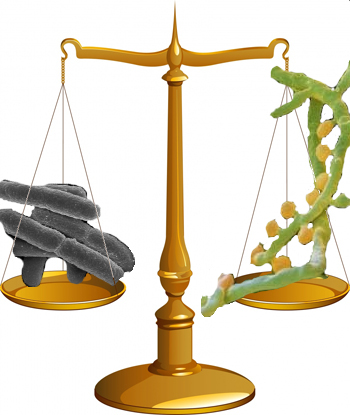
Fungi to bacteria ratio
 What is a fungi to bacteria ratio? The fungi to bacteria ratio
is simply the mass of fungi in the soil compared to the mass of
bacteria in the soil. In most cases, all you really need to know
is whether the soil is dominated by fungi, dominated by bacteria, or
has an even proportion of both.
What is a fungi to bacteria ratio? The fungi to bacteria ratio
is simply the mass of fungi in the soil compared to the mass of
bacteria in the soil. In most cases, all you really need to know
is whether the soil is dominated by fungi, dominated by bacteria, or
has an even proportion of both.
In nature, disturbed soils like those after a mudslide or in your
recently tilled garden have a strong bacterial dominance. As the
soil is left alone for a while, fungi start to move in until habitats
like prairies or your lawn have a relatively even proportion of fungi
and bacteria in residence. Later, as shrubs and trees take over,
the fungi in the soil build up even more so that forest soils are
strongly fungi dominated.
Scientists have started to look at the fungi to bacteria ratio
preferred by garden plants as well. They discovered that carrots,
lettuce, and crucifers enjoy strongly bacteria dominated soils while
tomatoes, corn, and wheat like soils that are closer to evenly matched
(though still leaning a bit toward bacteria.) On the other hand,
most perennials, shrubs, and trees like the soil to be full of fungi at
ratios from 10:1 to 50:1.
Clearly, folks like me who have been treating our trees just like our
lettuce beds need to stop!
| This post is part of our Teaming With Microbes lunchtime series.
Read all of the entries: |
Want more in-depth information? Browse through our books.
Or explore more posts by date or by subject.
About us: Anna Hess and Mark Hamilton spent over a decade living self-sufficiently in the mountains of Virginia before moving north to start over from scratch in the foothills of Ohio. They've experimented with permaculture, no-till gardening, trailersteading, home-based microbusinesses and much more, writing about their adventures in both blogs and books.
Want to be notified when new comments are posted on this page? Click on the RSS button after you add a comment to subscribe to the comment feed, or simply check the box beside "email replies to me" while writing your comment.
- Remove comment

- Remove comment
- Remove comment
- Remove comment
